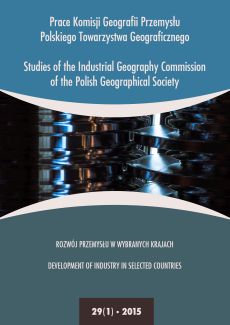Przestrzenne zróżnicowanie rozwoju nanotechnologii w Europie
DOI:
https://doi.org/10.24917/20801653.291.2Słowa kluczowe:
biomedyczne nauki, Europa, GOW, nanotechnologia, patenty, publikacjeAbstrakt
Celem artykułu jest przedstawienie przestrzennego zróżnicowania rozwoju nanotechnologii w Europie. Analizę rozwoju nanotechnologii przeprowadzono na poziomie krajowym, wykorzystując dane obrazujące liczbę patentów nanotechnologicznych, liczbę i strukturę firm nanotechnologicznych, liczbę konferencji o tematyce nanotechnologicznej oraz liczbę publikacji nanotechnologicznych. W artykule oparto się na analizie statystycznej danych liczbowych pozyskanych w wyniku kwerend przeprowadzonych na portalach internetowych: Cientifica Plc, Biotechgate, Nanoforum, Nanowerk, Nanotechnology Now, Web of Science i PubMed oraz danych publikowanych przez OECD i Eurostat. Nanotechnologia zaliczana jest do jednego z głównych działów aktywności sektora nauki, technologii i innowacji i jawi się współcześnie jako technologia przyszłości. Na całym świecie panuje przekonanie o rewolucyjnym potencjale nanotechnologii. W latach 2001-2014 ponad 60 krajów podjęło finansowanie inicjatyw z dziedziny nanotechnologii. Są to zarówno rozwinięte przemysłowo kraje Europy Zachodniej, Japonia, Kanada czy Australia, jak i wschodzące rynki Rosji, Chin, Brazylii i Indii, jak i kraje rozwijające się, np. Nepal i Pakistan. Według liczby zgłoszeń patentowych z nanotechnologii na świecie dominują kraje rozwinięte: USA, Japonia i Niemcy. W latach 90. XX wieku nastąpił wyraźny wzrost liczby patentów nanotechnologicznych. W przestrzeni europejskiej pod względem liczby patentów nanotechnologicznych dominują Niemcy oraz Francja i Wielka Brytania. Jeśli rozpatrujemy liczbę ogółu instytucji nanotechnologicznych, to wyróżniają się w Europie dwa kraje: Niemcy i Wielka Brytania. W Niemczech przeważają instytucje działające w relacji B2B, podczas gdy w Wielkiej Brytanii są to instytucje badawcze non profit. Analizując liczbę patentów i firm nanotechnologicznych oraz liczbę publikacji i konferencji, należy stwierdzić, że rozwój nanotechnologii w Europie jest bardzo zróżnicowany. Sektor ten rozwija się głównie w krajach rozwiniętych gospodarczo. Europejskim liderem nanotechnologicznym są Niemcy. Innymi państwami z wysokim poziomem rozwoju nanotechnologii są: Wielka Brytania, Francja, Szwajcaria, Szwecja, Holandia i Hiszpania. Rozwój nanotechnologii stymulowany jest głównie przez publiczne instytucje badawcze, jednakże komercjalizacja badań następuje dzięki udziałowi firm prywatnych.
Downloads
Metrics
Bibliografia
Bejerano, P.G. (2013, 6 września). Spain at the forefront of graphene production. Pozyskano z http:// blogthinkbig.com/en/spain-forefront-graphene-production.
Berger, M. (2013, 1 lipca). An overview of the European Union’s nanotechnology projects. Pozyskano z http://www.nanowerk.com/spotlight/spotid=31109.php.
Chen, H., Roco, M.C., Li, X., Lin, Y. (2008). Trends in nanotechnology patents. Mature nanotechnology, 3, 123–125.
Clunan, A.L., Rodine-Hardy, K. (2014). Nanotechnology in a Globalized World: Strategic Assessments of an Emerging Technology. CCC PASCC Reports, 6.
Crawley, T., Koponen, P., Tolvas, L., Marttila, T. (2012). Finance and investor models in nanotechnology. Pozyskano z http://www.oecd.org/sti/nano/49932116.pdf.
Cuenat, A., Winkless, L. (2010). Nanotechnology Survey. Summary Report. Teddington: Queens Printer and Controller of HMSO.
Dawidko, P. (2012). Biotechnologiczne spółki spin-off Uniwersytetu Jagiellońskiego jako mechanizm transferu technologii. Prace Komisji Geografii Przemysłu Polskiego Towarzystwa Geograficznego, 20, 95–107.
Dominiak, J., Churski, P. (2012). Rola innowacji w kształtowaniu regionów wzrostu i stagnacji gospodarczej w Polsce. Studia Regionalne i Lokalne, 4(46), 54–77.
Dorocki, S., Jastrzębski, J. (2012). Regionalne zróżnicowanie rozwoju biotechnologii w Europie. Prace Komisji Geografii Przemysłu Polskiego Towarzystwa Geograficznego, 20, 67–94.
Feder, B.J. (2003, 8 kwietnia). Frontier of military technology is the size of a molecule. The New York Times. Pozyskano z http://www.nytimes.com/2003/04/08/business/technology-frontier-of-military- technology-is-the-size-of-a-molecule.html.
Johnson, D. (2008). Nanotechnology in Russia is Booming… or is it? IEEE Spectrum Blog. Pozyskano z http://spectrum.ieee.org/tech-talk/semiconductors/devices/nanotechnology_in_ russia_is_bo.
Menz, N., Ott, I. (2011). On the role of general purpose technologies within the Marshall-Jacobs controversy: The case of nanotechnologies. ECONSTOR Working paper series in economics, 18. Pozyskano z http://hdl.handle.net/10419/44973
Poire, N.P. (2011). The Great Transformation of 2021. How the Looming Sustainability Crisis will Revolutionize Capitalism, Fracture the Nation-State, and Topple American Supremacy. Raleigh: Lulu-Norman P. Poire.
Porter, A.L., Youtie, J. (2009). Where does nanotechnology belong in the map of science? Nature Nanotechnology, 4, 534–536. Doi:10.1038/nnano.2009.207.
Raźniak, P., Nowotnik, D. (2015). Pozycja gospodarcza miast Europy Środkowo-Wschodniej na tle świata. Ekonomia Międzynarodowa, 4(23–39).
Raźniak, P., Winiarczyk-Raźniak, A. (2014). Sytuacja finansowa korporacji europejskich w dobie kryzysu, Prace Komisji Geografii Przemysłu Polskiego Towarzystwa Geograficznego, 27, 99–107.
Raźniak, P., Winiarczyk-Raźniak, A. (2015). Did the 2008 global economic crisis affect large firms in Europe? Acta Geographica Slovenica, 55(1), 127–139.
Rediguieri, C.F. (2009). Study on the development of nanotechnology in advanced countries and in Brazil. Brazilian Journal of Pharmaceutical Sciences, 45(2), 189–199.
Roszek, B., De Jonga, W.H., Geertsma, R.E. (2005). Nanotechnology in medical applications: state- of-the-art in materials and devices. Pozyskano z http://www.rivm.nl/en/Documents_and_publications/ Scientiffic/Reports/2005/oktober/Nanotechnology_in_medical_applications_state_of_ the_art_in_materials_and_devices.
Schimke, A., Teichert, N., Ott, I. (2012). Impact of local knowledge endowment on employment growth in nanotechnology. Working Paper Series in Economics, 38. Pozyskano z http://hdl.handle.net/10419/55142.
Winans, B.C., Kauhanen, L. The European Nanotechnology Innovation Landscape. W: European Nanotechnology Landscape Report, 12–32.
Wójtowicz, M., Dorocki, S. (2014). Regional differences in the development of the biotechnology industry in Latin America, with particular emphasis on Brazil and Mexico. W: M. Wójtowicz, A. Winiarczyk-Raźniak (red.). Environmental and socio-economic transformations in developing areas as the effect of globalization. Kraków: Wydawnictwo Naukowe Uniwersytetu Pedagogicznego, 111–135.
Pobrania
Opublikowane
Jak cytować
Numer
Dział
Licencja
Artykuły publikowane są zgodnie z warunkami licencji Creative Commons (CC BY-ND 4.0; uznanie autorstwa-bez utworów zależnych).

